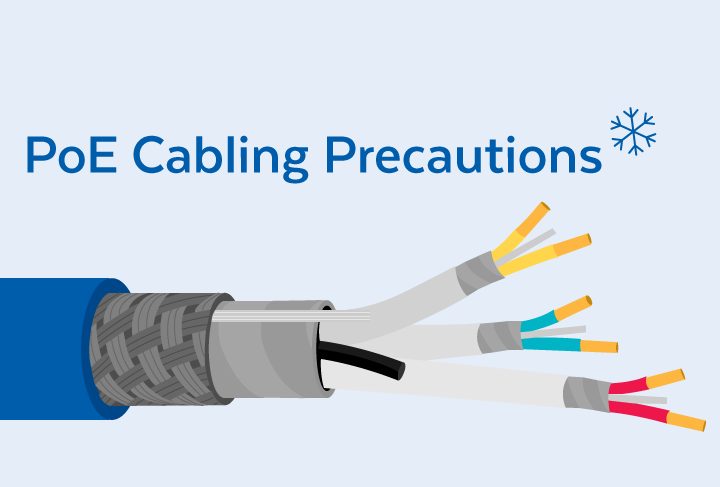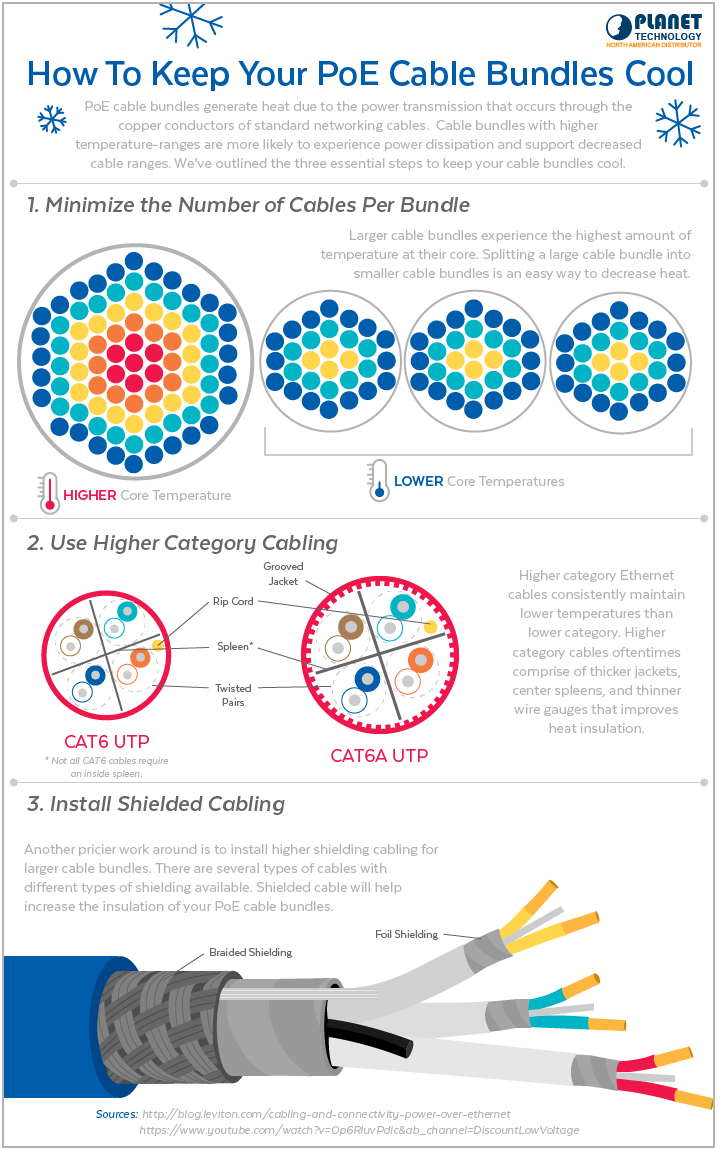PoE cable bundles generate heat due to the power transmission that occurs through the copper conductors of standard networking cables. Wiring cabinets or networking sites that do not allow for proper heat dissipation can lead to cable bundles with higher-temperature cores. Cable bundles with higher temperature ranges are more likely to experience power dissipation and support decreased cable ranges due to a high insertion loss. Insertion loss refers to the loss of power that occurs as power is transmitted between the input and the output of a device. And power dissipation can potentially contribute to a powered device operating with an undercurrent, which can cause connected devices to heat up. Even though powered devices are built to withstand heat, a device prone to over-heating can shorten its lifespan, increase bit errors, and affect the overall performance of connected devices. Not only can cable bundles with higher temperatures affect connected devices, but heat can also damage the actual networking cables as well.
Maintaining cable bundles cool has become increasingly important as newer PoE standards continue to increase higher power outputs. The 802.3at PoE+ standard delivers 30 watts of power to connected devices. That’s 15 additional watts of power than the original 802.3af standard. But the pending ratification of the 802.3bt Ultra PoE standard will introduce even higher power ranges. The 802.3bt standard specifies between 60 and 100 watts of power. Click here to learn more about 802.3bt. These new higher-powered PoEs standards make it essential to maintain cable bundles cool.
We’ve outlined the three essential steps to keep your cable bundles cool.
 1. Minimize the Number of Cables Per Bundle
1. Minimize the Number of Cables Per Bundle
Reducing the amount of heat generated in a cable bundle can be as easy as reducing the amount cables per bundle. Leviton sites that the Telecommunications Industry Association, or TIA for short, measured the temperature of a cable bundle consisting of 91 cables and proceeded to separate the large cable bundle into three separate cable bundles. TIA found that the core of the cable bundle experienced the highest amount of temperature in comparison to the core of the smaller bundles. Reducing the number of cables in a cable bundle helps reduce temperatures.
2. Use Higher Category Cabling
Higher category cabling will support more cables in a cable bundle and maintain them below the recommended 15 degrees Celsius as recommended by the Telecommunications Industry Association (TIA). Leviton engineers tested several category types of Ethernet using a varying amount of bundled cables. Results demonstrated that higher category cabling directly correlated with lower amounts of temperatures across all different test cases that utilized varying amounts of cables in bundles. Even if the number of cables per bundle increased, higher category Ethernet cables consistently maintained lower temperatures than lower category cables.
Higher category cables have spacers or spleens that help maintain the more tightly wound twisted pairs in place. Cat6a, for example, has tiny grooves in its jackets to further help the tightly wound twisted pairs stay in place. These modifications contribute to thicker jackets in higher category Ethernet types, not to mention that they oftentimes have slightly thinner wire gauges as well.
3. Install Shielded Cabling
Installing higher shielding cabling for larger cable bundles also reduces heat. There are several types of cables with different types of shielding available. But keep in mind that shielded cable will likely increase the bulk and weight of your cable bundle. Shielded cables are usually utilized for specific types of environments such as industrial networking environments. However, network installers and system integrators have the option of selecting UTP cables that shields twisted pairs. Want to become an expert on reading shielded and unshielded code for twisted pair copper? Click here for an in-depth explanation.
Check out our in-depth guide about PoE here!
Looking for PoE networking equipment? Click on the link below!

 1. Minimize the Number of Cables Per Bundle
1. Minimize the Number of Cables Per Bundle

Join the Discussion One Comment